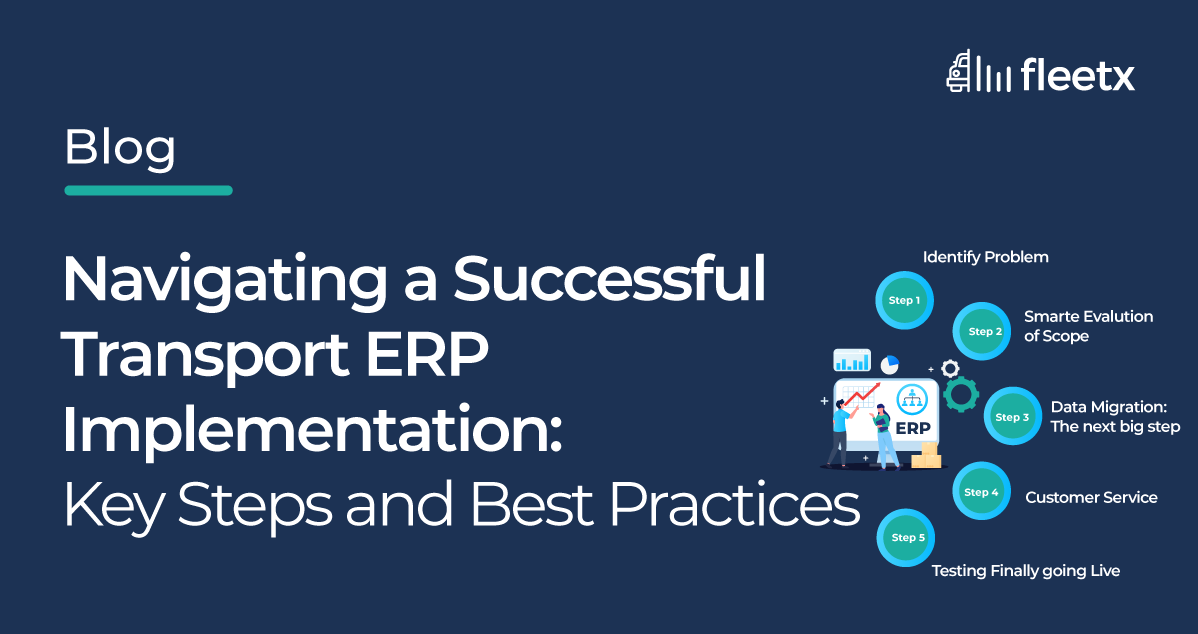
Implementing a Transport ERP system is an action of significance- it will revolutionize the way your fleet operates and generate several benefits for your company. However, the journey to a successful implementation is not without its challenges.
If companies don't follow proper ERP implementation protocols, they may encounter various challenges and potential issues throughout the process. Some of the common situations that arise as a result of improper ERP implementation include:
- Poor user adoption
- Inefficient operational processes
- Data inconsistencies
- Delayed timelines
- Integration challenges
- Insufficient vendor support
- Missed business opportunities
In this article, we will guide you through the key steps and best practices to navigate a successful Transport ERP implementation, and avoid falling into one of the traps mentioned above. By anticipating and addressing these challenges, you can streamline the implementation process and maximize the benefits of your ERP system.
Key Steps to Successful ERP Implementation
Define Clear Objectives and Requirements:
As a first step, it is essential to establish clear business objectives and future requirements. Define what you want to achieve with the ERP system, whether it's improving operational efficiency, enhancing customer service, or gaining better visibility into your fleet. Clearly outlining your goals will guide the implementation process and help you evaluate the success of the ERP system.
Conduct Thorough Vendor Evaluation:
Choosing the right ERP vendor is critical to the success of your implementation. Conduct a thorough evaluation of various vendors, considering factors such as industry fit, product functionality, scalability, customisation and customer support. Engage in detailed discussions and demonstrations to ensure that the chosen ERP system aligns with your specific business requirements.
Plan for Data Migration and Integration:
Migrating and integrating data from existing systems into the new ERP solution can be complex. Develop a detailed plan for data migration, ensuring data accuracy, integrity, and security. Consider the various data sources, formats, and potential challenges during the migration process. Collaborate closely with the ERP vendor to ensure a smooth transition.
Customize and Configure for Your Needs:
Every transport operation has unique requirements. Work closely with the ERP vendor to customize and configure the system according to your specific needs. Identify key business processes and workflows that require customization and ensure they are aligned with industry best practices to avoid complex challenges in the future.
Establish Strong Change Management:
Change management plays a critical role in successful ERP implementations: prepare your workforce for the changes that come with the new system. Communicate the benefits and address any concerns or resistance. Provide comprehensive training programs to ensure users are proficient with the ERP system. Encourage feedback and continuous improvement to drive user adoption and engagement.
Monitor and Evaluate Performance:
Regularly monitor and evaluate the performance of your ERP system after implementation. Establish key performance indicators (KPIs) and metrics to measure the system's effectiveness in achieving your defined objectives. Assess user feedback, system stability, and overall satisfaction to identify areas for improvement and address any issues promptly.
Best Practices for Successful ERP Implementation
Beyond a good implementation strategy, it is also suggested to look at the learnings from previous implementation efforts in other companies. Following these industry best practices can improve your implementation experience, and set your business up for success. A well-executed ERP implementation strategy will streamline your operations, enhance productivity, and drive business growth.
Form a Dedicated Project Team:
Establish a dedicated project team consisting of key stakeholders from various departments within your organization. This team will be responsible for overseeing the implementation process, coordinating activities, and ensuring effective communication between all parties involved.
Set Realistic Timelines and Milestones:
Create a realistic timeline for each phase of the implementation process. Break down the project into manageable milestones to track progress and ensure timely completion. Regularly review and adjust the timeline as necessary to accommodate unexpected challenges or changes in requirements.
Conduct Thorough Testing for Quality Assurance:
Testing and quality assurance are critical to ensure the ERP system functions correctly and meets your business needs. Develop a comprehensive testing plan that includes both functional and integration testing. Involve end-users in the testing process to gather valuable feedback and identify any gaps in the system. Make it an iterative process to create valuable feedback loops that provide relevant data.
Prioritize Data Accuracy and Cleansing:
Data integrity is essential for the success of an ERP implementation. Conduct a thorough data audit to identify inconsistencies, duplicates, and inaccuracies. Develop a data cleansing strategy to rectify these issues before migrating the data to the new system. Establish data governance practices to maintain data accuracy and consistency in the long term.
Provide End-to-End Training and Support:
Invest in comprehensive training programs to ensure that end-users are proficient in using the ERP system. Offer both initial training during the implementation phase and ongoing training to support users as they adapt to the new system. Provide dedicated support channels for users to address any questions or concerns they may have.
Conclusion
Implementing a Transport ERP system can be a game-changer for your fleet, but it requires careful planning and execution. By following these key steps and best practices, you can navigate the challenges and scale your business to new heights. Just remember to: define clear objectives, choose the right vendor, plan for data migration, customize the system to your needs, establish strong change management, and continuously monitor and evaluate performance. A well-executed Transport ERP implementation will optimize your fleet's operations, improve efficiency, and drive long-term success.


